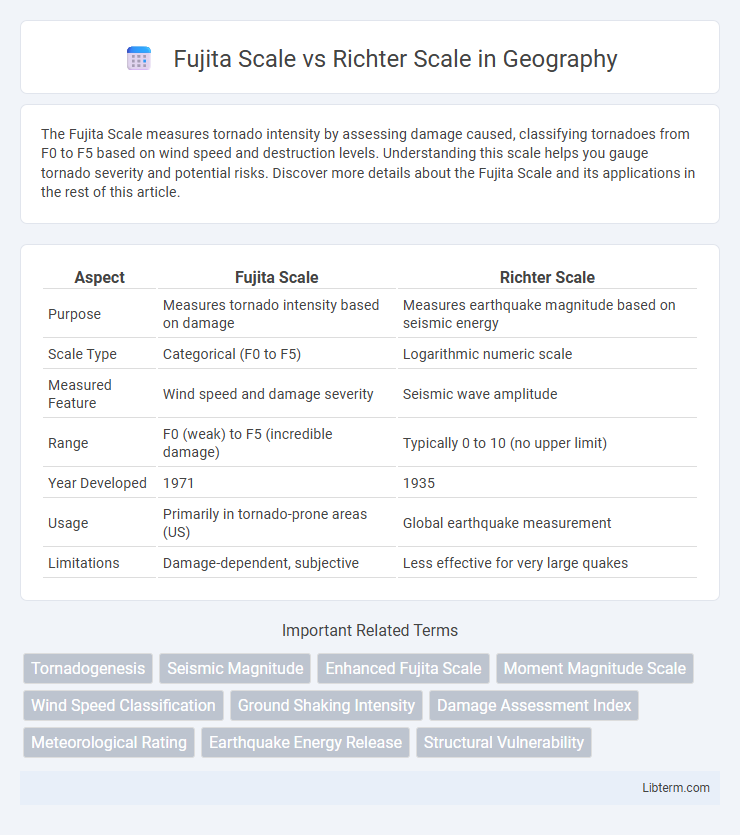The Fujita Scale measures tornado intensity by assessing damage caused, classifying tornadoes from F0 to F5 based on wind speed and destruction levels. Understanding this scale helps you gauge tornado severity and potential risks. Discover more details about the Fujita Scale and its applications in the rest of this article.
Table of Comparison
| Aspect | Fujita Scale | Richter Scale |
|---|---|---|
| Purpose | Measures tornado intensity based on damage | Measures earthquake magnitude based on seismic energy |
| Scale Type | Categorical (F0 to F5) | Logarithmic numeric scale |
| Measured Feature | Wind speed and damage severity | Seismic wave amplitude |
| Range | F0 (weak) to F5 (incredible damage) | Typically 0 to 10 (no upper limit) |
| Year Developed | 1971 | 1935 |
| Usage | Primarily in tornado-prone areas (US) | Global earthquake measurement |
| Limitations | Damage-dependent, subjective | Less effective for very large quakes |
Understanding the Fujita Scale
The Fujita Scale measures tornado intensity based on damage severity and wind speed estimates, ranging from F0 to F5. This scale evaluates structural damage and classifies tornadoes from weak to violent, providing critical data for assessing tornado impact. Unlike the Richter Scale, which quantifies earthquake magnitude through seismic energy, the Fujita Scale emphasizes observable damage patterns to understand tornado strength.
Overview of the Richter Scale
The Richter Scale measures the magnitude of earthquakes by quantifying the amplitude of seismic waves recorded by seismographs, typically ranging from 0 to 10, with each whole number increase representing a tenfold increase in measured amplitude. Developed in 1935 by Charles F. Richter, it provides a logarithmic scale useful for quantifying the energy released during tectonic events. Unlike the Fujita Scale, which assesses tornado intensity based on damage, the Richter Scale is a fundamental tool in seismology for objectively comparing earthquake strengths worldwide.
Historical Background of Both Scales
The Fujita Scale, developed by Dr. Tetsuya Fujita in 1971, was created to classify tornado intensity based on damage assessment, revolutionizing meteorological damage analysis. The Richter Scale, introduced in 1935 by Charles F. Richter, measures earthquake magnitude through seismic wave amplitude recorded on a seismograph, establishing a standardized method for quantifying earthquake strength. Both scales have undergone revisions to improve accuracy, with the Fujita Scale evolving into the Enhanced Fujita Scale in 2007 and the Richter Scale being supplemented by moment magnitude scales for precise earthquake measurement.
Key Differences Between the Fujita and Richter Scales
The Fujita Scale measures tornado intensity based on damage caused and wind speed estimates, ranging from F0 to F5, while the Richter Scale quantifies earthquake magnitude by recording seismic wave amplitude on a logarithmic scale. The Fujita Scale primarily assesses localized atmospheric phenomena, whereas the Richter Scale evaluates tectonic activity across a broader geographical area. Both scales serve distinct purposes in natural disaster assessment, with the Fujita Scale emphasizing structural damage and the Richter Scale focusing on energy release.
How the Fujita Scale Measures Tornado Intensity
The Fujita Scale measures tornado intensity by assessing the damage caused to man-made structures and vegetation, correlating observed destruction with estimated wind speeds to classify tornadoes from F0 to F5. Unlike the Richter Scale, which quantifies earthquake magnitude based on seismic wave readings, the Fujita Scale relies on post-storm damage surveys to infer wind velocity. This damage-based categorization enables meteorologists to estimate tornado strength and provide consistent historical comparisons of tornado events.
How the Richter Scale Measures Earthquake Magnitude
The Richter Scale quantifies earthquake magnitude by measuring the amplitude of seismic waves recorded by seismographs, with each whole number increase representing a tenfold increase in wave amplitude and roughly 31.6 times more energy release. This logarithmic scale enables precise quantification of the earthquake's size regardless of distance from the epicenter. Unlike the Fujita Scale, which assesses tornado intensity based on damage, the Richter Scale directly measures seismic energy to categorize earthquakes.
Applications in Severe Weather and Seismic Events
The Fujita Scale measures tornado intensity by assessing damage caused by wind speeds, making it essential for evaluating severe weather impacts and improving building codes in tornado-prone areas. The Richter Scale quantifies earthquake magnitude based on seismic wave amplitude, enabling precise assessment of seismic energy released during earthquakes and guiding emergency response efforts. Both scales serve critical roles in disaster preparedness, risk mitigation, and informing safety standards tailored to their respective natural hazards.
Limitations and Criticisms of Each Scale
The Fujita Scale, primarily used to rate tornado intensity, faces criticism for its reliance on post-event damage assessments, which can be subjective and inconsistent due to variable building structures. The Richter Scale, designed to measure earthquake magnitude, is limited by its decreasing accuracy for large or distant earthquakes, often underestimating true seismic energy release. Both scales lack real-time applicability and require supplementary tools for comprehensive disaster analysis and response.
Modern Alternatives and Evolving Methodologies
The Fujita Scale, primarily used for rating tornado intensity based on damage, has evolved into the Enhanced Fujita (EF) Scale, which incorporates more precise damage indicators and engineering assessments. The Richter Scale, once the dominant method for measuring earthquake magnitude, has been largely replaced by the Moment Magnitude Scale (Mw), offering greater accuracy for a wide range of seismic events. Modern methodologies leverage advanced sensor networks, satellite data, and machine learning algorithms to provide faster, more reliable assessments of natural disasters.
Importance of Accurate Disaster Measurement
Accurate disaster measurement through the Fujita Scale and Richter Scale is crucial for assessing tornado intensity and earthquake magnitude, respectively, enabling effective emergency response and preparedness. The Fujita Scale quantifies tornado damage to classify severity, while the Richter Scale measures seismic energy release, providing vital data for structural engineering and public safety. Reliable application of both scales supports disaster mitigation strategies and minimizes loss of life and property.
Fujita Scale Infographic

 libterm.com
libterm.com